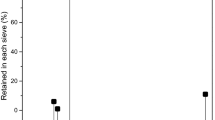Abstract
E-waste is the toxic legacy of our digital age, polluting drinking water and harming ecosystems all over the world. Printed circuit board (PCB) and compact disc (CD) are key components in most of the electrical and electronic components and considered to be the most problematic waste to recycle due to their heterogeneous combination of metal, polymer, and ceramics. In this study, a novel approach to transform waste PCB as a silicon source and waste CD as reductant carbon is investigated to produce ferrosilicon alloy. Characterization of the nonmetallic fraction of PCB indicates the presence of 50% silica, and the waste CD char shows good-quality carbon as reductant. The ferrosilicon synthesis process is based on carbothermal reduction and is carried out at 1550 °C under an argon atmosphere. The synthesized product was characterized using XRD, Raman, and EDS analysis, and the results indicated that the ferrosilicon alloy phase was that of Fe3Si with 14.8% silicon. This innovative approach of utilizing e-waste for synthesizing ferrosilicon alloy can be a sustainable solution for recovering resources from electronic waste and minimizes the utilization of nonrenewable traditional raw materials.







Similar content being viewed by others
References
Diaz LA et al (2016) Comprehensive process for the recovery of value and critical materials from electronic waste. J Clean Prod 125:236–244
Iannicelli-Zubiani EM et al (2017) Environmental impacts of a hydrometallurgical process for electronic waste treatment: a life cycle assessment case study. J Clean Prod 140:1204–1216
Zhang L, Xu Z (2016) A review of current progress of recycling technologies for metals from waste electrical and electronic equipment. J Clean Prod 127:19–36
Abdelbasir SM, El-Sheltawy CT, Abdo DM (2018) Green processes for electronic waste recycling: a review. J Sustain Metall 4(2):295–311
Huang K, Guo J, Xu Z (2009) Recycling of waste printed circuit boards: a review of current technologies and treatment status in China. J Hazard Mater 164(2):399–408
Zeng X et al (2012) Current status and future perspective of waste printed circuit boards recycling. Procedia Environ Sci 16:590–597
Cayumil R et al (2014) Generation of copper rich metallic phases from waste printed circuit boards. Waste Manag 34(10):1783–1792
Wang X et al (2010) PVC-based composite material containing recycled non-metallic printed circuit board (PCB) powders. J Environ Manag 91(12):2505–2510
Hadi P et al (2013) Novel application of the nonmetallic fraction of the recycled printed circuit boards as a toxic heavy metal adsorbent. J Hazard Mater 252–253:166–170
Guo J et al (2007) Phenolic molding compound filled with nonmetals of waste PCBs. Environ Sci Technol 42(2):624–628
Guo J, Guo J, Xu Z (2009) Recycling of non-metallic fractions from waste printed circuit boards: a review. J Hazard Mater 168(2):567–590
Sommerhuber PF, Wang T, Krause A (2016) Wood–plastic composites as potential applications of recycled plastics of electronic waste and recycled particleboard. J Clean Prod 121:176–185
Rajarao R et al (2014) Study of structural evolution of chars during rapid pyrolysis of waste CDs at different temperatures. Fuel 134:17–25
Rajarao R et al (2014) Synthesis of silicon carbide nanoparticles by using electronic waste as a carbon source. Mater Lett 120(Supplement C):65–68
Schei A, Tuset JK, Tveit H (1998) Production of high silicon alloys. Tapir Trondheim, Norway
Gasik M (2013) Handbook of ferroalloys: theory and technology. Butterworth-Heinemann, Waltham
Mansuri IA, Khanna R, Rajarao R, Sahajwalla V (2013) Recycling waste CDs as a carbon resource: dissolution of carbon into molten iron at 1550 °C. ISIJ Int 53:2259–2265
Sahajwalla V et al (2015) Recycling polymer-rich waste printed circuit boards at high temperatures: recovery of value-added carbon resources. J Sustain Metall 1(1):75–84
Farzana R, Sahajwalla V (2015) Novel recycling to transform automotive waste glass and plastics into SiC-bearing resource by silica reduction. J Sustain Metall 1(1):65–74
Farzana R, Rajarao R, Sahajwalla V (2014) Synthesis of ferrosilicon alloy using waste glass and plastic. Mater Lett 116:101–103
Duan H et al (2011) Characterization and inventory of PCDD/Fs and PBDD/Fs emissions from the incineration of waste printed circuit board. Environ Sci Technol 45(15):6322–6328
McKay G (2002) Dioxin characterisation, formation and minimisation during municipal solid waste (MSW) incineration. Chem Eng J 86(3):343–368
Duan H et al (2012) Characterizing the emission of chlorinated/brominated dibenzo-p-dioxins and furans from low-temperature thermal processing of waste printed circuit board. Environ Pollut 161:185–191
Rajarao R et al (2014) Novel approach for processing hazardous electronic waste. Procedia Environ Sci 21:33–41
Racu A-M et al (2007) Crystallographic disorder and electron-phonon coupling in Fe1–xCoxSi single crystals: Raman spectroscopy study. Phys Rev B 76(11):115103
Acknowledgements
The financial support for this research was provided by the Australian Research Council (ARC) Laureate Fellowship under the Grant No. FL140100215.
Author information
Authors and Affiliations
Corresponding author
Ethics declarations
Conflict of interest
The authors declare no conflict of interest.
Additional information
The contributing editor for this article was I. Sohn.
Rights and permissions
About this article
Cite this article
Rajarao, R., Farzana, R. & Sahajwalla, V. Transforming Waste Printed Circuit Boards and Compact Discs for the Synthesis of Valuable Ferrosilicon Alloy. J. Sustain. Metall. 4, 461–469 (2018). https://doi.org/10.1007/s40831-018-0194-0
Published:
Issue Date:
DOI: https://doi.org/10.1007/s40831-018-0194-0




